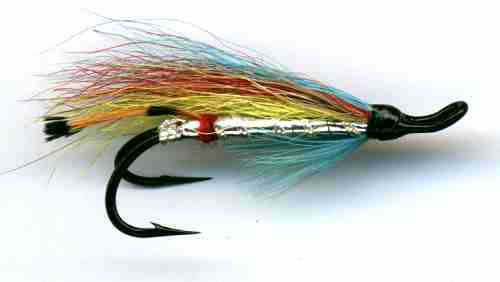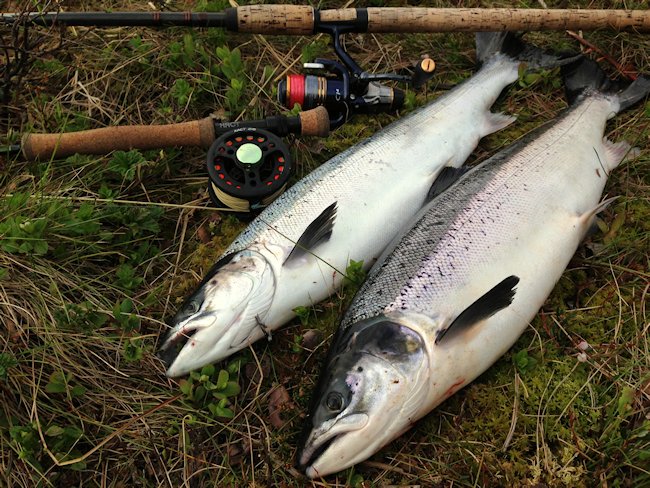The Silver Wilkinson Double Hook Salmon Fly
The original creator of the Silver Wilkinson is in dispute. In 1843 Mr William Henderson commissioned the salmon fly tier James Wright to tie a fly of similar description.

SALMON DOUBLE HOOK FLY PATTERNS. Hook size 4 6 8 10 - $US each
THE SILVER WILKINSON SALMON FLY
Canon William Greenwell of Greenwell's Glory fame also tied a similar fly but it is Mr P.S.Wilkinson whose name has been attached to this now popular modern salmon fly. It is a very good smoalt pattern. I have had great success with a Silver Wilkinson when fishing
for Salmon in Canada, Scotland and in Sweden. Bait fish have to move quickly in
order to survive and your fly must do the same. Ensure you maintain your
retrieve until you feel your line stop Salmon do not slam into the fly like
trout or bass usually do. With Coho especially you will sometimes see a wake
following your fly. Although it is exciting and can be unnerving it is important
that you keep the fly moving. Do not be tempted to slow up and let the Salmon
catch up. This is unnatural behavior for a bait fish and may spook your target
fish into rejecting your fly. I have found Dead-drifting around the edges of swirling
eddies also brings takes with this fly.

CUSTOMER'S PHOTO
One salmon was caught on a Silver Wilkinson double hook fly and the other on a Teal Blue and Silver double hook fly by Geir-Vidar Haugen in Northern Norway
FISHING FOR STEELHEADS
Although I was fishing for Pacific Salmon on my last trip to Western Canada I found the Silver Wilkinson caught a large number of Steelheads at a ratio of 2 steelheads caught to every Salmon. Steelheads are simply migratory rainbow trout. (A Sea Trout is the migratory form of the brown trout). They spawn in freshwater rivers and lakes, remain there for about two years, then migrate to the open sea where they will stay for another two to three years before they begin returning to their native rivers. Steelheads returning to their home rivers, will be fully mature and weigh between seven and ten pounds. Fish that have stayed in the ocean longer can reaching impressive sizes of 12 to 20 pounds or more. Unlike the migratory salmon, not all sea-run steelhead die immediately after spawning. About twenty percent of each steelhead generation that returns to freshwater to spawn make their way back down the rivers and into the sea again. Not many will be strong enough to make a second spawning run. Steelheads in the sea look very much like river trout until they begin their migration when they change to a bright silver, their backs a darker grey. Anglers call these trout "chrome bright," or "chromers." After they have been in freshwater for a time, however, steelhead slowly begin to take on the color patterns of true rainbow trout, with various patterns of black spots sprinkled across their backs, complete with smears of red on the cheeks, with distinctive red stripes marking their flanks. These red stripes can range in color from soft coral pink to a deeper blood-red color. The males fish are more colorful.
Migrations continue throughout the year, although the most active steelhead months are December, January, and March for winter steelhead; and June through August for the summer runs. Most steelhead rivers have only a summer or a winter run; some have both, and some experience no spring or summer steelhead runs at all hosting an autumn/fall and winter-run trout. It is mostly the big rivers, that have steelhead runs year-round. Winter-run steelhead become very single minded. It is the greatest run of trout in terms of numbers. All their energy is devoted to spawning. For the most part, when they do feed, or strike a fly, they seem to do so out of habit and instinct rather than true hunger. It is this instinct - the steelhead's curiosity that can work to the angler's advantage. They will still strike at a well-presented artificial fly. They are also exceptionally wary, nervous, and incredibly difficult to catch. Winter steelhead seem to be, by far, the spookiest of the migratory steelhead. In shallow, clear water. Even the hint of a shadow moving across the water startles them, sending them scurrying.
The spring and summer trout runs produce the highest quality of steelheads, in looks and sport. They are still sexually immature when they enter the rivers. They will spend more time in freshwater before they begin spawning. Most winter-run steelhead will spawn quickly and then return to the ocean, some do linger in the rivers throughout the winter and into the spring. Spring and summer-run trout will often remain in the rivers through the summer months. When these steelheads strike, they do so with a great deal more ferocity than winter-run trout. They fight like big saltwater fish and are one of the great game fish of the world.
The best way to insure good future fishing is to leave the females alone. Any bright fish is probably a hen on her way upriver, and should be left alone, although exceptionally large ones are a tempting target. Watch for female steelheads that turn on their sides and pump their tails, to scoop a hollow where they will drop their eggs. The scent stream of pheromones is like a magnet to the males. Hooking or otherwise spooking the females, is almost a guarantee that any near-by males will depart, and then there are NO fish to target. Accurately casting to the edges of the gathering steelhead male pack will get hits from the males. Cast far enough upstream of the fish to allow the fly to sink to their level before it gets to them. Drift the fly into the fish's face, and lifting and swinging away when it gets within a few inches. This method brings out their predatory instincts. You should see the strike using sun glasses. Set the hook with a downstream sweep of the rod. Play him away from the pack, to avoid spooking the rest of the fish.
Some smaller males will be chased off by larger males, and will drift back. A careful river bed presentation may elicit hard strikes from these fish. Keep the fly deep. Burn that into your brain. The fish are intent on spawning, rarely feed. You must get down to their level. It still makes sense to go by the old "Bright day-bright fly, dark day-dark fly" but don't get locked into it. Experiment with patterns and sizes. After missing a strike, I like to change to a smaller version of the same pattern. If that doesn't bring a hit, I go to a fly that's completely opposite of the original. A huge black egg sucking leech would replace a tiny Polar Shrimp.
GOOGLE+ READER'S COMMENTS
I saw the Silver Wilkinson for the first time about 5 years ago, when a veteran fly fisherman gave it to me as a gift. It is a great bright weather salmon fly that is increasing in popularity here in Iceland in recent years. I like smaller sizes.. preferable #12. The trend here in Iceland (in my opinion) is that all flies are getting smaller. #12, #14 and smaller is now common. I would use a fly like silver wilkinson with a double hook (I rearly use a single hook fly when salmon fishing and I have actually hardly ever seen single hook flies used for salmon fishing in Iceland) in size #12 and strip it with short, fast strokes. Alternative would be a version with longer tail that I would instead of a Sunrey. - Jon Pall Hreinsson

